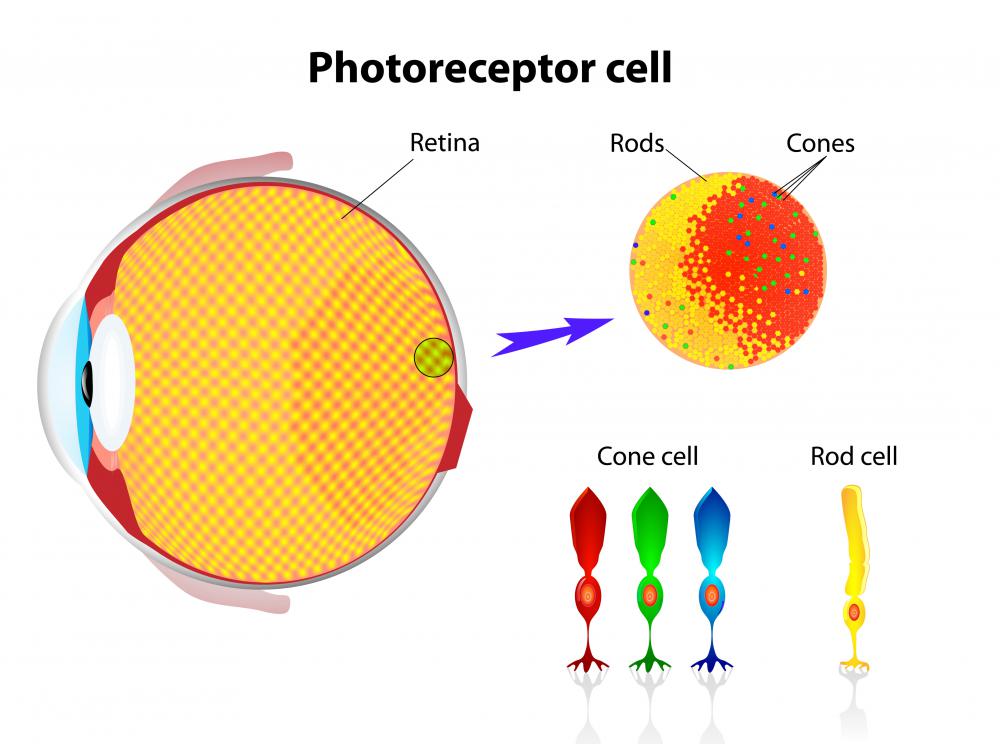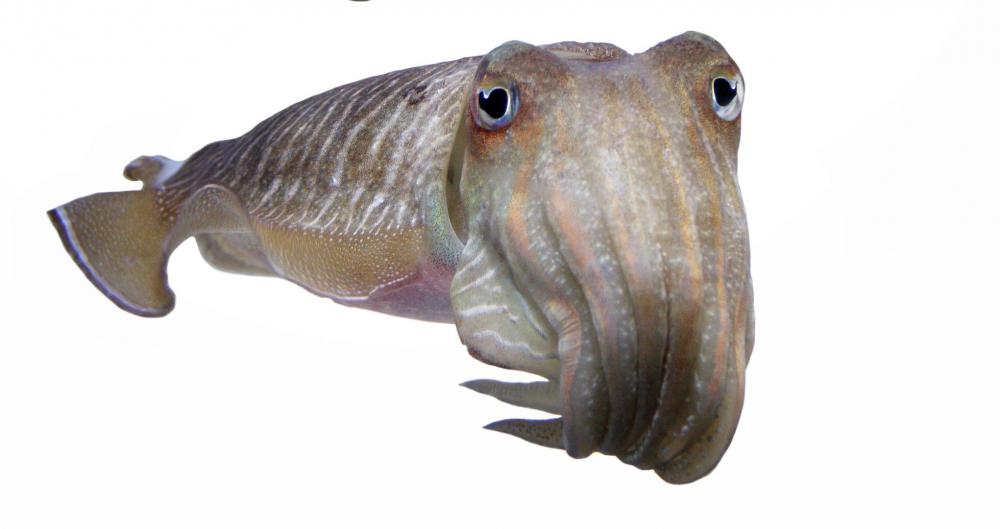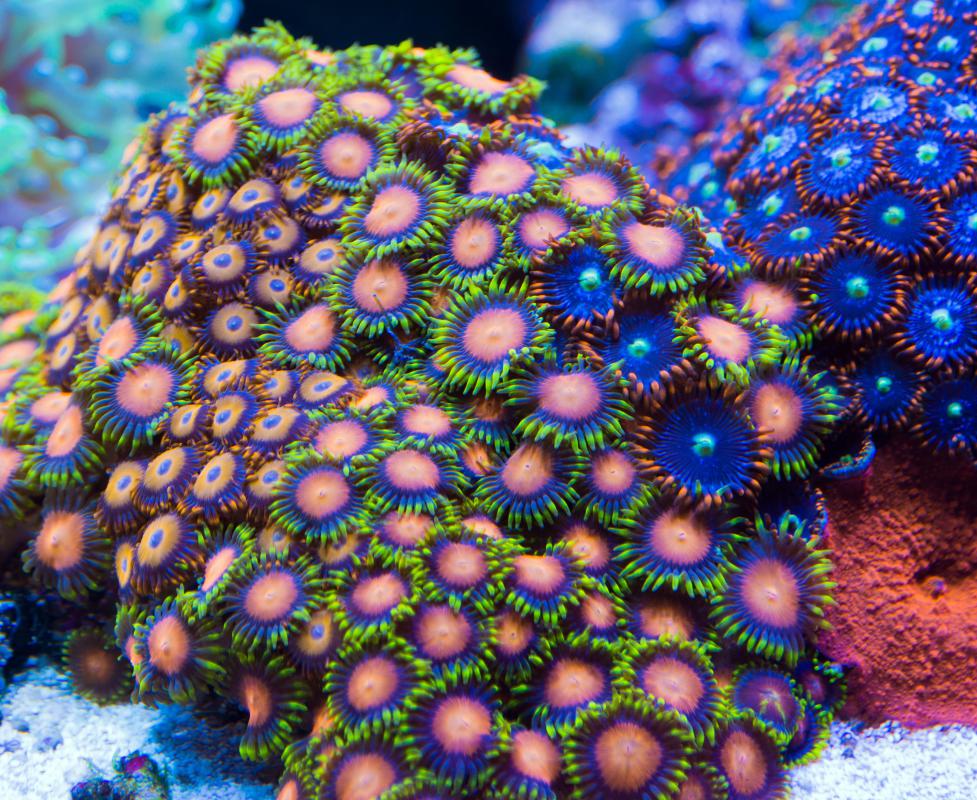At AllThingsNature, we're committed to delivering accurate, trustworthy information. Our expert-authored content is rigorously fact-checked and sourced from credible authorities. Discover how we uphold the highest standards in providing you with reliable knowledge.
Do Animals See in Color?
While the question is overbroad considering the millions of animal species including insects, the general answer is that scientists have reason to believe many if not most animals see in color to some extent. For simplicity, a very general rule is sometimes offered: most diurnal animals do see in color, while most nocturna animals don’t, but even here there are exceptions.
Animals and insects cover an exhaustive field of biological diversity. The majority of spiders have eight eyes and poor vision, while flies have hundreds of tiny lenses and near-360-degree vision. Eagles can spot a mouse from over one mile high (1.6 km), while a sloth has trouble seeing any animal that isn’t moving. Considering this vast diversity, whether or not animals see in color is a question that must be taken species by species.

In humans, rods and cones in the eye’s retina detect light and color, respectively. Rods allow us to see shapes in dim light and make our way down the hall in the middle of the night. Cones, which detect color, require more light to activate. For this reason you might notice that you don’t see color in the dark; instead, everything appears in shades of gray. Flip on a light, and the retina’s cones activate, relaying color information to the brain.

When considering whether animals see in color, one approach is to look to the structure of the eyes to see if cones are present. Many nocturnal animals that scientists have studied lack cones, relying instead on greater numbers of rods for extended night vision and keener detection of movement. As an exception to the nocturnal rule, owls do have cones, leading scientists to believe these animals do see colors. Most species of primates, birds, cats and dogs also see in color to some degree.

Humans have three sets of cones for detecting color in different wavelengths: cones that detect red wavelengths, cones that detect blue, and cones that detect green, though each cone detects a wide spectrum that overlaps to create other hues. Animals like cats and dogs have two sets of cones, making them color-blind to specific colors. They do, however, have many more rods than humans, giving them greater night vision and a keener ability to detect motion.

For example, dogs can’t distinguish between green and orange which will both look grayish. Toss a bright orange tennis ball across a green lawn and you’ll find a dog can follow it fine while it’s in motion. Once it comes to rest a distracted dog might lose the ball against the background. Only its shape will cause it to stand out. In humans, green color blindness is referred to as deuteranopia.
Feline animals see in color, but they have trouble distinguishing reds; the human counterpart being protanopia. Reds appear as differing shades of gray to a cat. It is believed both dogs and cats see mainly in grays, yellows, and blues.

Honeybees and butterflies have three pigment visual receptors with true color vision within their visual spectrum. This spectrum stops short of the infrared but extends into the ultra-violet beyond human vision. Not only can these animals see colors, they can detect a mix of colors as well as pure colors.
It is believed coral reef fishes see close to the same rich spectrum of colors that humans see, as evidenced by the many colors present in a coral reef environment. Though not an iron clad assumption, the animal kingdom has evolved bright coloring to both ward off predators and attract mates – an evolutionary feature that would seem to be lost on animals that cannot see color. However, exceptions exist here too and the assumption is somewhat general and speculative.
Sea mammals like sea lions, dolphins and whales possess a single type of cone for detecting patterns in light, but not colors. This is known as cone monochromacy and these animals are believed to be totally color-blind.

While it might be true that the animals we most closely associate with do not share the same rich spectrum of colors that humans enjoy, it’s probably safe to say that many diurnal animals see in color to some degree. Hence, the next time you find yourself walking down the aisle of your favorite pet store with your cat or dog in mind, you might pass up the red, green and orange toys to get something in a nice, bright shade of blue or yellow.
Frequently Asked Questions
Do all animals see in color?

No, not all animals see in color. Vision varies widely across the animal kingdom. Some animals, like humans and many primates, have trichromatic vision and can see a range of colors. Others, like dogs, have dichromatic vision and see fewer colors. Certain species, such as some nocturnal animals, may see in limited color or none at all, focusing more on light intensity and movement.
How do the eyes of animals differ from human eyes in perceiving color?

Animals' eyes often contain different types and numbers of photoreceptor cells compared to humans. For instance, humans have three types of cone cells for color vision, while dogs have only two, which limits their color perception. Birds, on the other hand, can have four types of cone cells, allowing them to see ultraviolet light in addition to the visible spectrum.
Can any animals see colors that humans cannot?

Yes, many animals can see colors beyond the human visible spectrum. For example, bees and butterflies can see ultraviolet light, which helps them locate nectar in flowers, a phenomenon invisible to humans. Birds also have the ability to perceive ultraviolet light, enhancing their ability to see more colors than humans can.
What is the purpose of color vision in animals?

Color vision in animals serves various purposes, such as finding food, selecting mates, and avoiding predators. For instance, vibrant plumage in birds can be a signal of fitness to potential mates, while the ability to distinguish plant colors can help herbivores identify nutritious foliage or ripe fruits.
How does color vision affect an animal's behavior?
Color vision can greatly influence an animal's behavior. Predators may rely on color vision to spot prey against a contrasting background, while prey animals might use it to recognize warning colors of predators or toxic species. In mating rituals, color vision allows animals to display and recognize specific visual signals.
Are there any animals known for having the most complex color vision?
Mantis shrimps are renowned for having the most complex color vision system known in the animal kingdom. They possess up to 16 types of photoreceptor cells for color analysis, far surpassing the human trichromatic vision system. This extraordinary vision enables them to detect subtle differences in their underwater environment.
AS FEATURED ON:
AS FEATURED ON:




















Discussion Comments
I think it's arrogant of humans to say that we know everything about animals just because we've dissected parts of them or we've put them through tests. Until they speak to us, I'm withholding my total belief of scientific findings as being 'that's all there is". I keep thinking of "So long, and thanks for all the fish" - the message from the dolphins, the fourth book in the Hitchhiker's Guide to the Galaxy series, just before the Earth was going to be destroyed.
Do deer see in colors and the human aura?
There's something refreshing about the lack of color on a moonlit night outdoors. Everything is suddenly equal, because it is all bathed in shades of blue-grey light, and it's very calming. There's no sensory overload.
@anon65827 – I've heard that bees can see colors, but they can't see red. They don't just rely on sight to find the flowers, though. They also rely on scent.
A good example of this is an apple tree. The blossoms are white and pink, and since a bee can't see red hues, it probably doesn't know this. However, the scent is very strong and wonderful, so my apple trees are literally swarming with bees in the spring.
I've also heard that butterflies can see much better than bees. They can even see red. So, they might be a bit better at finding nectar.
The animals that only see blues and yellows get to enjoy a couple of things that nature has to offer. They can see the beauty of a blue sky and the pretty yellow sunlight on a cloudless day.
My golden retriever loves to fetch balls, but I've noticed that he can't tell where the bright orange one is if he loses track of it in the air. He has a bad habit of running ahead before I throw the ball, so he often has to listen for the bounce when it lands.
Many times, it has rolled to a stop while he is desperately searching for it. It has always amazed me that he couldn't see that neon orange ball lying in the grass, but now I know why.
Just because we use color for wavelength information does not mean a predator would. It is more likely that a predator's brain would have evolved color coding in their vision for movement information in the same way we show doppler radar in color.
I suspect if anything moves the dog's vision lights up in color giving an idea of direction and acceleration. This could be why dogs are such enthusiastic car passengers as the rapid movement would create a kaleidoscope of colours. You cannot assume from the absence of eye receptors that color vision is missing. --Mike D.
are there any animals that see in the ultra-violet range?
So does this allow animals to see angels? Since they have strong blue and yellow tones in their aura and not red?
Animals are able to distinguish certain colours, so isn't it obvious that if animals are to survive they would have to adapt to the colours that their predator or helper would be able to see? otherwise how would they survive?
It would be ridiculous if animals can't see in color. I mean, many snakes, plants, fish and such have very strong colors, telling the other animals that they are poisonous! If they can't see colors anyway, what's the point in it?
Also, flowers have strong colors! If the bees can't see in color, what use would the strong color have?
Do deer see in color?
What color do turtles see?
do bulls actually see red?
Do kangaroos have cones in their eyes? Do they see in color? -Matt
Post your comments